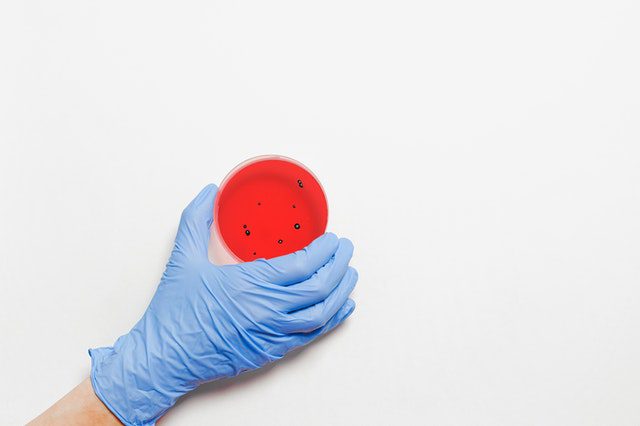Can the coronavirus survive on surfaces? According to a few studies reported by the World Health Organization (WHO) surfaces like plastic and stainless steel harbor the COVID-19 virus for up to 72 hours. The WHO further states that the virus can survive on cardboard and copper surfaces for less than 24 and 4 hours, respectively.
The medical industry recognizes the importance of hand hygiene and sanitization. Disposable gloves have always been an essential tool among the PPE (personal protective equipment) for health care experts. But with the arrival of COVID-19, the demand for disposable gloves has increased outside the hospital community. Why? Because coronavirus survives on surfaces and because you can contract coronavirus from touching a contaminated surface. These facts makes wearing disposable gloves a part-n-parcel of the preventive protocol against contracting the coronavirus. The demand for disposable gloves skyrocketed since the start of 2020. According to ResearchAndMarkets.com, the disposable glove market is expected to rise by 670% in the wake of the COVID-19 pandemic. Disposable gloves and masks have become a must-have essential for the fight against the coronavirus. Read on to know how coronavirus survives on surfaces and what preventive measures you can take to protect yourself and your family.
Coronavirus And Different Surfaces
“Can you get coronavirus from touching contaminated surfaces?” people often ask.
The reason behind the rapid spread of the disease is that it is a droplet infection. This means that the coronavirus remains alive in our nasal and oral secretions. When we sneeze or cough, these secretions land on surfaces around us. These surfaces act as inactive sources for the spread of disease. These inactive sources of infection are also called the fomites or fomes. Fomites can sustain disease-causing agents for variable times. The same is true for coronavirus. So to answer the question as to whether coronavirus can survive on surfaces, the answer is yes.
When an infected person sneezes out in the open, droplets land on surfaces around them. If others touch these surfaces and then touch their face, nose, or mouth, there’s a chance these people can also become infected with the virus.
Have you ever wondered how far that one sneeze travel? Forgetting to cover your mouth or nose while coughing or sneezing may not sound like a big deal for many. But in fact, it is a part of basic etiquette and covering your nose or mouth-cover will also lower the risk of the spread of diseases. These include illnesses like the common flu and of course COVID-19.
You may not see them, but droplets from your nose and mouth travel fast and travel far. A Massachusetts Institute of Technology (MIT) study reported that sneeze droplets travel up to a distance of 26 feet. The study also noted that sneezing can move at a speed of 100 miles per hour. Who would have thought! Do you think you can move away from a person’s sneeze fas t enough to escape the droplets and its effect espeicially with COVID on the rise?? It’s unlikely. This is why social distancing is so essential in order to protect yourself from the COVID-19 virus. The study at MIT also shows that surfaces can become contaminated from coronavirus germs which means this – you can get coronavirus from touching such contaminated surfaces.
Knowing what you know now, it makes more sense when doctors tell you:
- Sneeze or cough inside your elbow
- Use a tissue while sneezing
- Wash your hands often
- Use hand sanitizer
- Use disposable gloves and wear masks
- Stop touching your face, mouth and nose
- Keep at least 6-feet distance from others when out in public places
How long does the coronavirus last on clothes, paper and other surfaces?
Coronavirus spreads from one person to another. The spread usually occurs through larger droplets from sneezes and coughs and small aerosol droplets. The larger droplets are are big and easily settle on surrounding surfaces. The infectious virus gets transferred there and stays for a while before going dead.
The aerosol droplets are tiny and small, like the ones released from air fresheners or perfumes. They hang in the air and travel and they transmit the infections from one person to another before settling down on to some surface. No matter their size, it is proved that droplets from the nose and mouth can cause coronavirus to spread.
Although it is possible, the risk of transference of coronavirus from touching of contaminated surfaces is low. Yet several studies are trying to find how long the virus can stay alive on different surfaces. The length of time varies for each surface. Researchers believe it can be from a few hours to days on surfaces like doorknobs and countertops. Here is some updated data on the length of time coronavirus can survive on different surfaces:
- the virus stays on metal surfaces like doorknobs, jewelry, silverware and cookware for about five days
- surfaces made of wood like furniture, doors, wood rails, and decks retain the virus for about four days
- Plastics like the one used for detergent bottles and bus seats, backpacks, or elevator buttons keep the virus alive for 2 to 3 days
- stainless steel surfaces like refrigerators, pots and pans, sinks, countertops, door handles, metal handrails, keys, cutlery, industrial equipment harbor the virus for 2 to 3 days
- cardboard as shipping and packaging boxes hold the virus for 24 hours
- copper like the one used in pennies and coins, tea-kettles, jewelry, electrical wires keep the virus alive for 4 hours
- aluminium like soda cans, tin foil, water bottles, window panes, and sills, doors hold the virus for two to eight hours
- glass such as drinking glasses, measuring cups, mirrors, windows, retain the virus for up to five days
- stuff made out of ceramic like dishes, pottery, mugs, planters and tiles keeps the virus for five days
- paper (paper money, letters, and stationery, magazines or newspapers, tissues, paper towels and toilet paper) harbors different coronavirus strains for different time periods. The stay of the virus may last from a few minutes to about five days
- there is no evidence that coronavirus spreads through food and other dietary items. Coronavirus cannot grow in food. It needs a living host to reproduce
- similarly, water as in drinking supplies does not accommodate the coronavirus. There are no chances of coronavirus in filtered water
- all kinds of fabrics like clothes, linens, bed sheets, etc. cater the virus to stay for few minutes to hours
- the soles of our shoes might harbor the virus. A study conducted in China recently revealed that the virus remains were found on the soles of the hospital staff’s shoes
- the exact time for the virus staying on skin and hair is not known. That is why health experts emphasize the importance of frequent hand wash. This is important after touching any surface or exposure to environment outside your home
What can you do to protect yourself and your family from COVID-19 virus?
Researchers are also trying to find out the effects of temperature on the viability of the coronavirus. Yet, the belief is that coronavirus does not survive high temperature and high humidity levels. The virus survives best in cooler and dry environments. So what do you do to combat the virus in different places where there are variable temperatures? Chances are you will come in contact with all kinds of surfaces. How do you then protect yourself from getting infected outdoors and indoors?
The World Health Organization provides very detailed instructions on how to keep yourself safe. Here are some tips:
1. identify high-touch areas in your homes, workplaces and outdoors. They include:
- door handles and knobs
- elevator buttons
- countertops
- sinks and food prep areas
- bathroom taps
- touch screens of cell phones
- key chains and keys
- wallets
- remote controls
- keyboards of all kinds etc.
2. make a routine to clean and disinfect these areas daily
3. make sure to first clean surfaces that are dirty, then disinfect afterward
4. for cleaning purposes, soap and water suffice. Chemicals like hydrogen peroxide, ethanol and sodium hypochlorite (an element in bleach) are quick to inactivate coronavirus on surfaces. They also help to remove the virus from a surface altogether. These chemicals are found in over-the-counter cleaning liquids and household sprays. They should only be used for surfaces and should not have direct contact on skin
5. always start cleaning from the most area to the dirtiest one. Change cleaning cloth s frequently
6. for cleaning the indoors, do not use a spray to disinfect the surfaces. Always use a cloth or wipe soaked in disinfectant to clean surfaces
7. for cleaning and disinfecting homes and workplaces, prepare a DIY disinfectant. Take five tablespoons of everyday chlorine-containing bleach in five gallons of water or mix four teaspoons in a quart of water. Alternatively, you can use an alcohol-based solution that is at least 70% alcohol. It is better to make a fresh solution every day. Leave the disinfectant on the surfaces for at least a minute before wiping it off
8. wipe the packaging of grocery items and let them air dry
9. if you use reusable grocery bags, wash them after each use
10. wash clothes and linens in warm soapy water and dry them thoroughly. Wash the laundry of a person infected with coronavirus separately. Handle such cloth while wearing disposable gloves
11. due to the COVID-19 virus social distancing protocol, the trend of online purchases has risen. Make sure to disinfect all such packages outside before bringing them inside your home
12. prevention is better than cure. Do not bring your outdoor shoes inside the house. If convenient, you can wipe the soles with a disinfectant solution
Precautions to take before disinfecting surfaces
While disinfectants remain the mainstay when it comes to cleaning the surfaces. It is vital to protect yourself and your family while using them. Here is what you need to do:
- carefully select a disinfectant. The chemical composition of the cleaning agent should not damage the surfaces. It should also be allergen-free in case any of the family members has allergy issues
- do not combine chemicals without any prior knowledge. Mixing ammonia and bleach can produce certain gases and fumes. They can cause hazardous respiratory symptoms
- while preparing a DIY disinfectant, make sure you are in a well-ventilated room or better do it outdoors
- make sure to keep your pets and children away from the area being disinfected. Let the disinfectant dry completely
- ensure proper ventilation while using disinfectant solutions. Open up the windows. Switch on the exhausts and fans for cross ventilation
- properly wash your hands after handling chemicals, disinfectants and alcohol wipes
- try to make a new solution of disinfectant every day. If that is not possible, keep the liquids in containers with lids. Keep the tops tightly closed at all times
- keep the disinfectant solutions out of reach of the children. In case of a home-made disinfectant, label the containers
- disinfectant wipes should never be used to clean hands. Their alcohol content may cause allergic reactions. Try to wear disposable gloves while handling disinfectant solutions
- clean electronic devices carefully. Use alcohol-based wipes for cleaning electronics. A 70% ethanol spray is also effective against the virus. Ensure the electric appliances are completely dry before using them
- always throw away disposable gloves and other items after disinfecting surfaces
Can the coronavirus survive on surfaces? Research says yes. However, the time of survival for the virus is variable on different surfaces. Factors like humidity and temperature also play their role. Can you contract COVID-19 virus by touching a surface? The answer is no. That is why it is not necessary to wear disposable gloves while outdoors.
Can you get coronavirus from touching contaminated surfaces? Well yes. If you suspect a surface is contaminated with coronavirus, then you must wash your hands or use an alcohol-based hand sanitiser.
Do not let your guard down completely because we’re still dealing with this pandemic. The COVID-19 virus has re-emerged in several parts of the world. Wash your hands frequently, practice good respiratory hygiene, wear masks and keeping a safe social distance – these are some of the crucial preventive measures against coronavirus. Till researchers come up with a vaccine, we have to live by new norms of the COVID-19 era.








